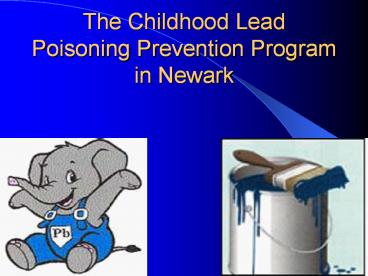The Childhood Lead Poisoning Prevention Program in Newark - PowerPoint PPT Presentation
1 / 10
Title:
The Childhood Lead Poisoning Prevention Program in Newark
Description:
Lead is a poisonous metal that can be absorbed by the body, primarily through ... Damp-mop floors, damp-wipe surfaces, and frequently wash a child's hands, ... – PowerPoint PPT presentation
Number of Views:101
Avg rating:3.0/5.0
Title: The Childhood Lead Poisoning Prevention Program in Newark
1
The Childhood Lead Poisoning Prevention Program
in Newark
2
What is Lead?
- Lead is a poisonous metal that can be absorbed by
the body, primarily through the lungs and
stomach. Lead poisoning occurs only when too much
lead accumulates in the body. Generally, lead
poisoning occurs slowly, resulting from the
gradual accumulation of lead in bone and tissue
after repeated exposure.
3
Who is at Risk for Lead Poisoning?
- Children under the age of six years old are more
vulnerable because they are growing so rapidly
because at that age children tend to put their
hands and objects into their mouth. - Children living in old, deteriorating housing.
Lead-based paint is still the major source of
childhood lead poisoning.More than half of
Contra Costa cases have been linked to lead-based
paint.Statewide percentages are even higher. - Pregnant Women or Women who may become pregnant
4
Who should be tested for possible lead poisoning?
- Children with learning or behavioral problems
- Children who have a sibling, housemate or
playmate being followed or treated for an
elevated lead level. - Children who live in or regularly visit a house
with peeling or chipping paint built before 1960.
This also includes day-care, pre-school or the
babysitter's house. - Children living near environmental sources of
lead, such as battery manufacturing plants, lead
smelters, battery recycling plants or other lead
industries
5
What Every Parent Should Know About Lead
Poisoning In Children
- For children at risk for lead exposure, a simple
blood test can prevent a lifetime spoiled by the
irreversible damage caused by lead poisoning. - Lead poisoning can cause learning disabilities,
behavioral problems, and at very high levels,
seizures, coma, and even death. - Children between 12 and 36 months of age have a
lot of hand to mouth activity, so if there is
lead in their homes, they are more likely to take
it in than are older children. - One of the most important risk factors for lead
exposure is the age of housing. Over 80 percent
of all homes built before 1978 in the U.S. have
lead-based paint in them. The older the house,
the more likely it is to contain lead-based paint
and a higher concentration of lead in the paint. - According to recent CDC estimates, 890,000 U.S.
children age 1-5 have elevated blood lead levels,
and more than one-fifth of African-American
children living in housing built before 1946 have
elevated blood lead levels. These figures reflect
the major sources of lead exposure deteriorated
paint in older housing, and dust and soil that
are contaminated with lead from old paint and
from past emissions of leaded gasoline.
6
Sources of Lead
- Soil
- Dirt and Dust
- Pesticides
- Paint
- Windowsills
- Tap Water
- Old painted toys and furniture
- Greta
- Azarcon
- Gasoline Additives
- Food can solder
- Ceramic Glaze
7
Effects of Lead Poison?
- Behavior Problems
- Anemia
- Fatigue
- Depression
- Damage to the nervous system, kidneys, Brain
and/or hearing - Speech and language problems
- Developmental delay
- Low I.Q.
8
Lead Poisoning Prevention
- Clean household surfaces and floors often by wet
wiping, not sweeping, which can kick up lead
dust. - Put duct tape or contact paper over peeling paint
and plaster. - Wash your childrens hands often, especially
before eating, naps, bedtime and any occasion
when their hands are near their mouths. - Frequently wash items children put in their
mouths, including bottles, pacifiers, toys and
blankets - Flush lead from drinking water by running cold
water for about one minute before using it. - Feed children foods high in iron and calcium,
which can reduce the bodys digestion of lead.
9
Treatment for Lead Poison
- Testing Contact your physician or local health
department to request a blood test specifically
for lead levels. - Chelation therapy is the most common treatment
when lead poisoning levels have reached an
elevated level.
10
What the public and parents can do to reduce
blood lead levels
- Ask a doctor to test your child if you are
concerned about your child being exposed to lead.
- Talk to your state or local health department
about testing paint and dust from your home for
lead if you live in a house or apartment built
before 1978, especially if young children live
with you or visit you. - Damp-mop floors, damp-wipe surfaces, and
frequently wash a childs hands, pacifiers, and
toys to reduce exposure to lead. - Use only cold water from the tap for drinking,
cooking, and for making baby formula. Hot water
is more likely to contain higher levels of lead,
and most of the lead in household water usually
comes from the plumbing in your house, not from
the local water supply.

